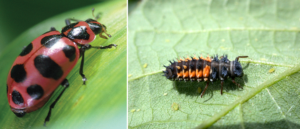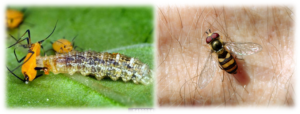There are so many different kinds of insects, but we often focus on the ones that cause damage (for obvious reasons). However, there are many beneficial, predatory insects you can be on the lookout for in your fruit plantings! These insects can be seen throughout the season, attacking aphids, mealybugs, caterpillars, mites, and even scale insects in your fruit plantings! Because they may look totally different between the immature and adult stages, I wanted to highlight a few common predatory insects in this issue, so you can learn to recognize ‘who’ the good insects are, and rest assured they are doing their good works in your orchard!

Figure 1. Pink spotted lady beetle (left) and an immature lady beetle larva (right). Photo credit: John Obermeyer
Lady beetles (and their larvae) (Figure 1): Ahh, the charismatic lady beetle! Both the adult and immature life stages of lady beetles eat small, soft-bodied insects, like aphids, mealybugs, and even the eggs of some pest insects. I think the larvae look like little alligators, and some might be surprised to learn that lady beetle larvae look so different from the adult beetles that we recognize so easily. Some lady beetles also eat pollen to get a healthy dose of protein! There are many different species of lady beetles, some that are native and some that are not native. If you’d like to learn more about the different lady beetle species you might spot, you can take a look at the Buckeye Lady Beetle Blitz Identification Guide. See how many of these lady beetles you can find throughout the season!

Figure 2. Lacewing larvae eating an aphid (left) and an adult green lacewing (right). Photo credit: Brian Christine
Lacewing larvae (Figure 2, left): Also known as ‘aphid lions,’ lacewing larvae are fierce predators that also crawl along on plants to find soft-bodied insects, like aphids, mealybugs, or eggs to eat. These insects may be missed more easily if you don’t take a closer look, because they are pretty small and not as colorful – but they are so cool! When lacewing larvae complete their development, they emerge as these cool-looking brown or green winged-adults that do not feed (Figure 2, right), besides sipping a bit of nectar to fuel their flight. The adults may be spotted hanging on the undersides of leaves of plants/trees during the morning and evening hours.

Figure 3. Hover fly larva eating an aphid (left) and an adult hover fly on someone’s arm (right). Photo credits: North Carolina State Extension and John Obermeyer.
Hover fly larvae (Figure 3, left): We all know the adult hover flies, as they are often mistaken for bees given their black and yellow coloring. If you listen carefully though, you’ll notice the hover flies don’t make the same buzzing noise that most bees do as they fly around you. Adult hover flies are important as pollinators, but the larvae are another fierce predator of soft-bodied insects, especially aphids! Unlike the lacewing larvae, hover fly larvae look more like a typical maggot; that is, there’s no obvious head and they don’t have legs. So, they may appear like slugs, wriggling along the top or bottom of leaves in search of prey! They are small and easy to miss, but if you do see one, leave them be (even if they are a bit strange looking!).

Figure 4. An assassin bug (in this case a wheel bug) (left) eating a spotted lanternfly, and a damsel bug eating a plant bug (right). Photo credits: James Occi and Ralph R. Berry
Damsel bugs & Assassin bugs (Figure 4): These predatory insects eat other insects by first piercing them with their beak- or straw-like mouthparts and then sipping out their body fluids! Many assassin bugs are colorful, often with warning colors like red, black, or yellow, while damsel bugs are more drab in color and easy to miss. Regardless of their coloration, these insects are also fierce predators and can be seen eating anything from other insect’s eggs to caterpillars, stink bugs, aphids and more! I’m always amazed to see these insects take down prey that are bigger than they are themselves! Just a note if you see assassin bugs and want to get a closer look, take care because they may bite (i. e., stab your finger with their beak-like mouthpart, ouch!!)

Figure 5. A parasitoid wasp looking for a San Jose scale to lay its egg in (left) and a samurai wasp laying eggs in a clutch of stink bug eggs (right). Photo credits: Jack Kelly Clark and Chris Hedstrom
Parasitoid wasps and flies (Figure 5): Parasitoids are insects that require only a single host to complete their entire life cycle, and this is different from predatory insects listed above, which must eat many insects to complete development from egg to adult. Parasitoid wasps and flies can be tiny or large and their colors vary a lot too. Parasitoid wasps are often referred to as ‘stingless wasps’ because they don’t often sting people; instead, they are looking to sting other insects to lay an egg (or many eggs) inside them! The egg hatches within the insect and the larva feeds on the insect internally, eventually killing it and emerging out of its body cavity as an adult (like in the Alien movies, eep!)! Parasitoid flies have a similar strategy as parasitoid wasps, except that the flies cannot sting, so their egg is often laid directly on or near the insect host rather than inside it. Many of you may be familiar with the parasitoid wasps that attack aphids, or the parasitoid flies that attack monarch caterpillars. One group of parasitoid wasps that may be particularly exciting to readers are the samurai wasps, which attack the eggs of brown marmorated stink bugs!
Keep a lookout for these good insects in your fruit orchard and before you know it, you may have a favorite one to watch – one of my favorites are the lacewing larvae!